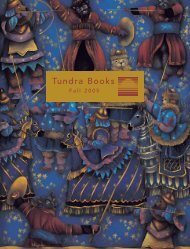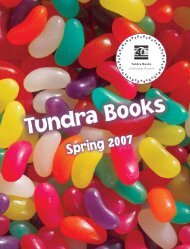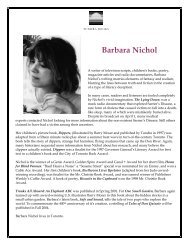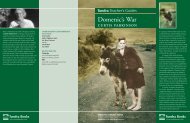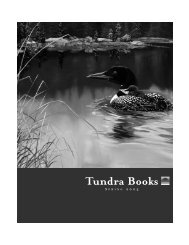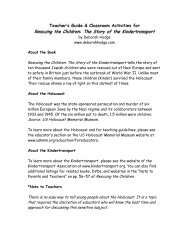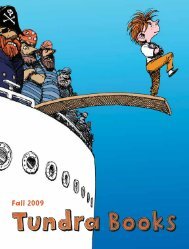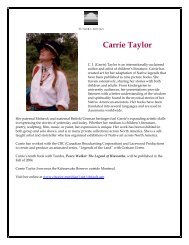World Vision Early Readers - Tundra Books
World Vision Early Readers - Tundra Books
World Vision Early Readers - Tundra Books
Create successful ePaper yourself
Turn your PDF publications into a flip-book with our unique Google optimized e-Paper software.
I like to Play Grades K-3<br />
I Like to Play<br />
Guided Reading<br />
Activities<br />
Language Arts, Literacy,<br />
Social Studies and Arts<br />
Preparation<br />
• Make a KWL Chart (What I Know, Want to Know and Learned)<br />
on chart paper (see Appendix A), or display on an interactive<br />
whiteboard.<br />
• Provide large sticky notes, one per student.<br />
• For the art activity, provide coloured construction paper, stock<br />
paper or cardboard (12x18), plus scissors and glue for each student.<br />
• Obtain a copy of I Like to Play by Marla Stewart Konrad (<strong>Tundra</strong><br />
<strong>Books</strong>, 2010).<br />
• Have a world map, globe or digital image ready for identifying<br />
countries represented in the photos.<br />
Instructions<br />
Before Reading: Activating Prior Knowledge<br />
Show students the KWL chart. Point to the K column of the chart<br />
and tell students you want to find out everything they know about<br />
how children play. Tell students to imagine themselves at play. Ask:<br />
What images come to mind when you hear the word play? What<br />
or whom do you like to play with? Where and when do you play?<br />
Why do you play? Ask students to share their thoughts with the<br />
class. Record their responses in the K column of the KWL chart.<br />
Students will<br />
• Identify cultural similarities and differences<br />
between the way children around the<br />
world play<br />
• Develop oral, visual and written literacy<br />
and kinesthetic skills<br />
• Generate and express ideas by responding<br />
to and reflecting on photographic images<br />
• Make text-to-self, text-to-text and text-toworld<br />
connections<br />
Related International Dates<br />
International Literacy Day (September 8)<br />
National Child Day (November 20)<br />
<strong>World</strong> Storytelling Day (March 19)<br />
Multiculturalism Day (June 27)<br />
I Like to Move It!<br />
Students sit on chairs in a circle, with one student standing in the<br />
middle as Move It. Move It makes a statement such as “If you like<br />
to play on the beach (play hockey, play on the computer, play with<br />
paint, play with your sister, etc.), move it!” All those who like to<br />
play on the beach jump up from their seats, run to the middle and<br />
make an action like they are playing on the beach before finding a<br />
new empty chair. The student in the middle also scrambles for an<br />
empty seat. The person left standing becomes the new Move It. If<br />
Move It calls out, “I like to move it, move it!” everyone gets up and<br />
finds a new chair. If students are having difficulty coming up with<br />
statements, direct their attention to the ideas in the KWL chart.<br />
I Want to Know…<br />
Show students the cover of I Like to Play as well as one or two<br />
photos in the book (or use the photos provided in the Reproducible<br />
Master). Ask: What do you think happens in this book? Tell students<br />
the photos show children from countries around the world. What<br />
is different about how children in Canada play and the ways other<br />
children play? What is the same? What more do you want to know<br />
about how other children play? Record class questions in the W<br />
column of the KWL chart.<br />
I Like to Play<br />
Read the book out loud to students, using the following questions to<br />
prompt discussion about the photos. See the list of photo credits at<br />
the beginning of the book.<br />
<strong>World</strong> <strong>Vision</strong> <strong>Early</strong> <strong>Readers</strong><br />
14




